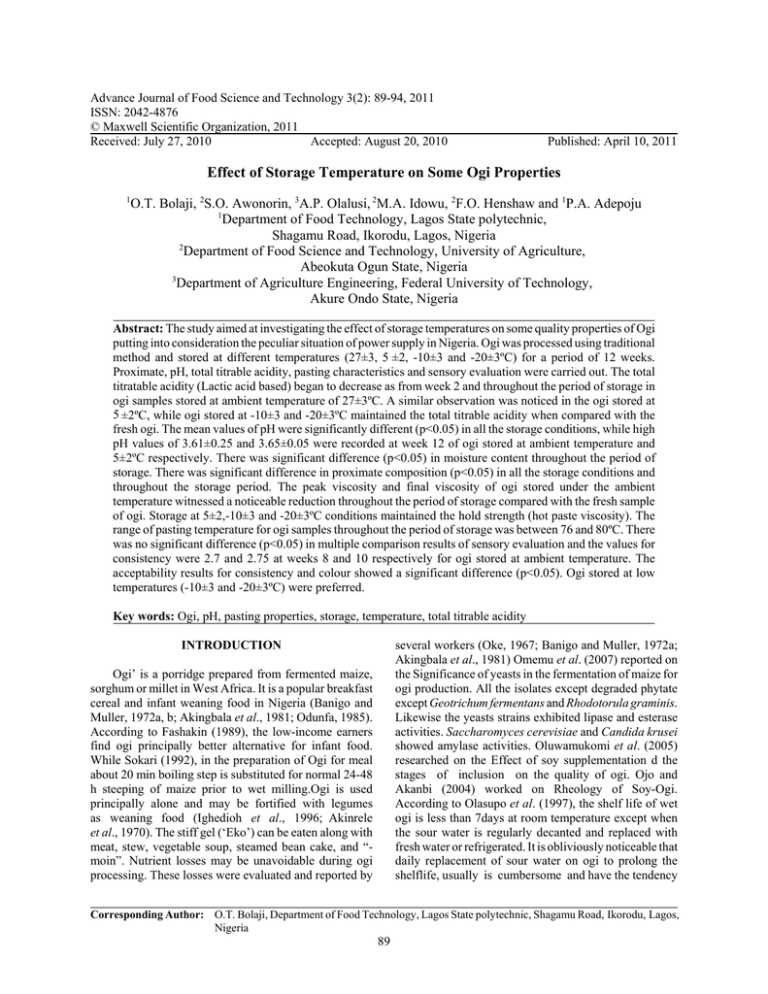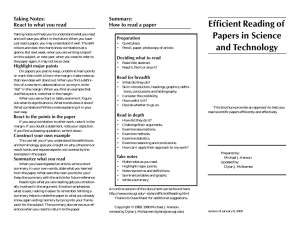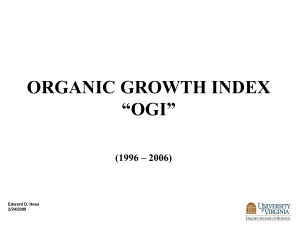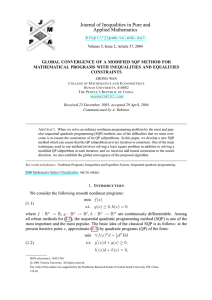Advance Journal of Food Science and Technology 3(2): 89-94, 2011
advertisement

Advance Journal of Food Science and Technology 3(2): 89-94, 2011 ISSN: 2042-4876 © Maxwell Scientific Organization, 2011 Received: July 27, 2010 Accepted: August 20, 2010 Published: April 10, 2011 Effect of Storage Temperature on Some Ogi Properties 1 O.T. Bolaji, 2S.O. Awonorin, 3A.P. Olalusi, 2M.A. Idowu, 2F.O. Henshaw and 1P.A. Adepoju 1 Department of Food Technology, Lagos State polytechnic, Shagamu Road, Ikorodu, Lagos, Nigeria 2 Department of Food Science and Technology, University of Agriculture, Abeokuta Ogun State, Nigeria 3 Department of Agriculture Engineering, Federal University of Technology, Akure Ondo State, Nigeria Abstract: The study aimed at investigating the effect of storage temperatures on some quality properties of Ogi putting into consideration the peculiar situation of power supply in Nigeria. Ogi was processed using traditional method and stored at different temperatures (27±3, 5 ±2, -10±3 and -20±3ºC) for a period of 12 weeks. Proximate, pH, total titrable acidity, pasting characteristics and sensory evaluation were carried out. The total titratable acidity (Lactic acid based) began to decrease as from week 2 and throughout the period of storage in ogi samples stored at ambient temperature of 27±3ºC. A similar observation was noticed in the ogi stored at 5 ±2ºC, while ogi stored at -10±3 and -20±3ºC maintained the total titrable acidity when compared with the fresh ogi. The mean values of pH were significantly different (p<0.05) in all the storage conditions, while high pH values of 3.61±0.25 and 3.65±0.05 were recorded at week 12 of ogi stored at ambient temperature and 5±2ºC respectively. There was significant difference (p<0.05) in moisture content throughout the period of storage. There was significant difference in proximate composition (p<0.05) in all the storage conditions and throughout the storage period. The peak viscosity and final viscosity of ogi stored under the ambient temperature witnessed a noticeable reduction throughout the period of storage compared with the fresh sample of ogi. Storage at 5±2,-10±3 and -20±3ºC conditions maintained the hold strength (hot paste viscosity). The range of pasting temperature for ogi samples throughout the period of storage was between 76 and 80ºC. There was no significant difference (p<0.05) in multiple comparison results of sensory evaluation and the values for consistency were 2.7 and 2.75 at weeks 8 and 10 respectively for ogi stored at ambient temperature. The acceptability results for consistency and colour showed a significant difference (p<0.05). Ogi stored at low temperatures (-10±3 and -20±3ºC) were preferred. Key words: Ogi, pH, pasting properties, storage, temperature, total titrable acidity INTRODUCTION several workers (Oke, 1967; Banigo and Muller, 1972a; Akingbala et al., 1981) Omemu et al. (2007) reported on the Significance of yeasts in the fermentation of maize for ogi production. All the isolates except degraded phytate except Geotrichum fermentans and Rhodotorula graminis. Likewise the yeasts strains exhibited lipase and esterase activities. Saccharomyces cerevisiae and Candida krusei showed amylase activities. Oluwamukomi et al. (2005) researched on the Effect of soy supplementation d the stages of inclusion on the quality of ogi. Ojo and Akanbi (2004) worked on Rheology of Soy-Ogi. According to Olasupo et al. (1997), the shelf life of wet ogi is less than 7days at room temperature except when the sour water is regularly decanted and replaced with fresh water or refrigerated. It is obliviously noticeable that daily replacement of sour water on ogi to prolong the shelflife, usually is cumbersome and have the tendency Ogi’ is a porridge prepared from fermented maize, sorghum or millet in West Africa. It is a popular breakfast cereal and infant weaning food in Nigeria (Banigo and Muller, 1972a, b; Akingbala et al., 1981; Odunfa, 1985). According to Fashakin (1989), the low-income earners find ogi principally better alternative for infant food. While Sokari (1992), in the preparation of Ogi for meal about 20 min boiling step is substituted for normal 24-48 h steeping of maize prior to wet milling.Ogi is used principally alone and may be fortified with legumes as weaning food (Ighedioh et al., 1996; Akinrele et al., 1970). The stiff gel (‘Eko’) can be eaten along with meat, stew, vegetable soup, steamed bean cake, and “moin”. Nutrient losses may be unavoidable during ogi processing. These losses were evaluated and reported by Corresponding Author: O.T. Bolaji, Department of Food Technology, Lagos State polytechnic, Shagamu Road, Ikorodu, Lagos, Nigeria 89 Adv. J. Food Sci. Technol., 3(2): 89-94, 2011 to reduce the nutritional value through loss of watersoluble nutrients (Teniola, 1990). Statics shows that about one-third of the total population of Nigeria people consume ogi at least once a week (Steinkraus, 1996). This created a high demand in the cities, which was not met with increasing population. Also women that would normally produce ogi have less time for domestic duties (Teniola, 1990). If these ever increasing demand for the product must be met, there must be better and less time consuming means of storage to prolong shelf life of ogi and make it available at all time with its quality still intact. This will necessitate the manipulation of some factors such as temperature, moisture content, pH and acidity to prolong the shelf life. Thus, this study attempted to investigate the effect of cold storage temperatures (5±2ºC, -10±3ºC and -20±3ºC) on some quality properties of ogi, considering the peculiar situation of power supply in our beloved nation, while Ambient temperature (27±3ºC) is used as control. determined by dipping the electrode of Schoff and Gerateca 714 pH m in th esample. The pH meter was standardized at 4 and 7. Total titratable acidity: Total titrable acidity (lactic acid base) was determined by titrating 0.1M NaOH was titrated against 20 mL prepared from 8 g of Ogi diluted with 80 mL of distilled water (AOAC, 1984). Pasting/cooking characteristics determination: A Rapid Visco Analyzer (RVA) was used to determine the pasting characteristic of the ogi slurry Oven-dried to 8% (w/w dry solid basis). Sensory evaluation: A 20-member panel consisting of adults was used to evaluate the “ogi” porridge samples. The panel was untrained but consisted of ogi consumers. The selection was based on familiarity, interest and availability. Ogi porridge (akamu) was prepared by mixing 100 g of ogi slurry collected at different storage conditions at week 2, 8 and 10 diluted to 50 mL with water. In a transparent 1000 mL plastic bowl and 400 mL of boiled water at 100ºC was used to gelatinize the sample, this was further boiled for 5 min and allowed to cool to 50-60ºC before serving randomly on coded transparent plastic and disposable cup and spoon. A 5point scale was used for the difference test (multiple comparison tests). Where 5 stands for no difference, and 1 extreme difference. Nine points’ hedonic scale was used for the acceptability test. Where 9 rates “like extremely” and 1 rate “dislike extremely. The Responses obtained from the panels were subjected to statistical analysis. Analysis of Variance (ANOVA) and the Duncan Multiple Range Test (DMRT) were used to check significant difference among means. MATERIALS AND METHODS Dried yellow maize (Zea mays) used in this study was obtained from local grain dealer at Osiele, Abeokuta, Nigeria. This study was carried out partly in the Food Science and Technology Laboratory, University of Agriculture, Abeokuta and pasting properties was carried out crop Utilisation unit of International Institute of tropical Agriculture (IITA) Ibadan. The production techniques and various modifications of O|gi have been documented in many articles (Odunfa, 1985; Odunfa and Adeyele, 1985; Chavan and Kadan, 1989; Onyekwere et al., 1989; Steinkraus, 1996). About 14 kg of cleaned maize was steeped in cold water for 72 h at ambient temperature, which was wet milled and wet sieved. The slurry was subsequently allowed to sediment and fermented for 2 days. About 250 g-drained ogi was put in each of small plastic bowl of volume 250ml. Ogi samples were stored at ambient temperature of 27±3ºC and Relative humidity of 72±4% with regular decantation and refilling with tap water at interval of two days for 12 weeks, in a domestic refrigerator at 5±2ºC and relative humidity of 79±0.5%, at freezing temperature of -10±3ºC and relative humidity of 80± 4% and -20±3oC and relative humidity of 80±4. Total titrable acidity, and pH were carried out at 0, 2, 4, 6, 10 and 12th week. The proximate were carried out at 0, 2, 8, and 12th week while pasting properties and sensory evaluation were carried out at 0, 2, 8 and 12th weeks respectively. The data were subjected to analysis of variance (ANOVA, and where means were significantly different, Duncan Multiple Range Test (DMRT) was used to separate the means. Moisture content and proximate Moisture, fat, ash, crude fibre and carbohydrate content were determined by the standard methods described by AOAC (1984). The pH was RESULTS AND DISCUSSION Total titrable acidity (%TTA): The total titratable acidity (lactic acid based) is presented in Fig. 1. The values shows a significant different (p<0.05). Total titrable acidity of ogi stored at ambient Temperature (27±3ºC) experienced a reduction from 1.0 at week 2 to 0.65±0.02 at week 12. A similar observation was noticed in ogi sample stored at 5ºC at week 8 through week 12. The total titrable acidity of ogi samples stored at temperatures of -10±3ºC and -20±3ºC remained the same through out the period of storage. The reduction in total titrable acidity (lactic acid based) observed in ogi stored at ambient temperature (27±3ºC) from week 2 and from week 8 for ogi stored at 5±2ºC in week 8 could be due to the irregular increase and decrease in population of lactic acid bacteria that was observed by Teniola (1990). The higher and constant total titrable acidity maintained in 10±3ºC and -20±3ºC through out the period of storage is 90 Total titrable Acidity % Adv. J. Food Sci. Technol., 3(2): 89-94, 2011 Fresh T3 1.2 T1 T4 Table 1: pH of Ogi slurry during different storage temperatures Week 27±3ºC 5±2ºC -10.±3ºC -20±3ºC 0 (fresh ogi ) 3.50 3.50 3.50 3.50 2 3.54 3.57 3.48 3.48 4 3.57 3.59 3.42 3.45 6 3.53 3.59 3.50 3.50 8 3.52 3.63 3.49 3.49 10 3.53 3.52 3.46 3.44 12 3.61 3.65 3.43 3.43 T2 1.0 0.8 0.6 0.4 0.2 0.0 2 6 8 4 Period of storage (Weeks) 0 10 12 -20±3ºC, the variation in pH levels noticed in the sample storage condition may be attributed to the difference in the trend of activities of microorganisms reported by Teniola, (2000). Extension in storage period of ogi stored at ambient temperature (27±3ºC) and 5±2ºC will definitely encourage increase in pH beyond the recommended value of 3.7 by Akingbala et al. (1981) with the trend of the pH values obtained. This possible increase of pH with time may permit many spoilage and pathogenic microorganism to grow and cause spoilage (Brown and Booth, 1991). Fig. 1: Total titrable acidity of ogi slurry during storage T1 = Ogi sample stored at Temperature 27±3ºC T2 = Ogi sample stored at Temperature 5±2ºC T3 = Ogi sample stored at Temperature -10±3ºC T4 = Ogi sample stored at Temperature -20±3ºC 58 Fresh ogi 27"3°C 5"2°C Moisture content (%) 56 -10"3°C -20"3°C 54 Moisture content: Figure 2 shows the moisture content of ogi during storage. There was a noticeable deviation from the moisture content throughout storage period in ogi sample stored at ambient temperature (27±3ºC) compared with fresh ogi. This is however expected since there is regular decantation and refilling of water of ogi stored at this temperature as practiced in the traditional setting. There was significant difference (p<0.05) between fresh sample, sample stored at ambient temperature and at 5±2ºC, -10±3ºC and -20±3ºC. The Pearson correlation for moisture content showed a significant difference (p<0.01). The moisture content of ogi stored at temperatures -10 ±3ºC and -20±3ºC was converted to ice crystal which was not useful to any microorganism, as long as the condition is maintained and the period of total thawing is not immediate 2 h, after removal from freezer or disconnection of freezer from power source. 52 50 48 46 0 2 4 6 8 Period of Storage (weeks) 10 12 Fig. 2: Moisture content of ogi during storage an indication of a better shelf-life at these storage temperatures and an inhibition of activities of micro organism. The activities of microorganism and enzymes were reduced by the conversion of moisture or free water into ice at -10±3ºC and -20±3 (Adams and Moss, 1995). The total titrable acidity values for ogi stored at ambient temperature were below the minimum recommended as safe and acceptable by Olatunji (1977) from 4th week. This implies that ogi stored under this condition may not be safe for consumption at weeks between 2nd and 3rd week. Total titrable acidity at other storage temperatures: 5±2ºC, -10±3ºC and -20± were within the recommended value of 0.79-1.2% (Olatunji, 1977). There may be further reduction in total titrable acidity at temperature 5±2ºC if the storage period is prolonged beyond 12 weeks. Table 1 shows the pH values of ogi slurry during storage in all the four storage temperatures. The values were significantly different (p<0.05) throughout the period of storage. Ogi sample stored at ambient temperature (27±3ºC) and at 5±2ºC increased compared to the value for fresh samples, which was 3.54±0.05 with highest value, recorded at week 12. Such was not observed in ogi stored at low temperatures of -10±3ºC and Proximate composition: The proximate composition of ogi samples for all the storage conditions throughout the storage period are shown in Table 2 .The varying values obtained in the protein and crude fibre can be attributed to the effect of processing and uneven distribution of these compositions as a result of processing of the ogi (Oke, 1967; Adeyemi, 1983; Akinrele, 1970). Sensory evaluation: Table 3 shows the multiple comparison and acceptability result respectively. The mean score for sourness, Aroma and colour throughout the storage condition and for all the storage temperatures were between 3 and 3.70, this implies that there were moderate difference in ogi sample stored at all the storage temperatures, with the exception of weeks 8 and 91 Adv. J. Food Sci. Technol., 3(2): 89-94, 2011 Table 2: Proximate composition of ogi at storage temperatures Week Ash (%) Crude fibre (%) Fresh ogi 0 0.19 1.86 Temperature (27±3ºC) 2 0.14 1.49 4 0.09 0. 42 8 0.01 1 .14 12 0.07 0.62 Temperature (5 ± 0ºC) 2 0.19 0.99 4 0.15 0.50 8 0.15 0.15 12 0.15 1.42 Temperature (-10± 3ºC) 2 0.18 0.50 4 0.15 0.30 8 0.15 2.97 12 0.15 2.57 Temperature (-20± 3ºC) 2 0.15 1.79 4 0.15 1.45 8 0.15 1.52 12 0.15 0.58 Values are means and standard deviations of 20 panelists Protein (%) Fat (%) Carbohydrate (%) 2.18 0.15 45.22 2.34 1.69 1.65 1.75 0.13 0.11 0.10 0.10 42.37 42.54 41.71 41.62 1.69 1.79 2.43 2.22 0.13 0.14 0.23 0.22 45.51 45.85 43.34 46.59 1.85 2.66 2.24 2.11 0.14 0.22 0.21 0.219 46.98 46.36 44.35 43.90 2.49 2.02 1.49 2.17 0.22 0.21 0.14 0.18 44.88 44.89 45.14 45.47 Table 3: Sensory evaluation of akamu prepared from ogi during storage Attributes 27±3ºC 5±2ºC -10±3ºC -20±3ºC Multiple comparison (Difference test) Akamu prepared during storage Week 2 Sourness 3.20±0.32 3.05±0.69 3.35±0.35 3.40±0.82 Aroma 3.00±1.03 3.50±0.69 3.50±0.69 3.40±0.50 Consistency 3.25±0.85 3.15±0.88 3.20±1.10 3.00±0.79 Colour 3.40±1.09 3.60±1.14 3.70±0.86 3.65±0.81 Week 8 Sourness 3.40±1.09 3.15±0.93 3.10±1.37 3.40±1.23 Aroma 3.60±1.19 3.10±1.12 3.15±0.10 3.50±0.97 Consistency 2.70±1.26 3.30±0.73 3.15±0.87 4.15±0.99 Colour 3.30±1.08 3.55±1.15 3.35±0.87 3.05±0.88 Week 10 Sourness 3.10±1.16 3.20±1.05 3.20±1.35 3.05±1.35 Aroma 3.00±0.86 3.45±0.89 3.45±0.98 3.15±0.99 Consistency 2.75±1.41 3.25±0.96 3.25±0.87 3.15±0.87 Colour 3.30±0.73 3.60±0.94 3.60±1.09 3.45±1.09 Consumer acceptability test of ogi during storage Week 2 sourness 5.85±2.46 6.85±1.57 6.15±1.137 6.15±1.67 Aroma 5.75±2.05 6.60±1.67 6.10±1.41 6.10±1.04 consistency 6.50±1.82 ab 7.05±1.27 a 6.90±.78 a 6.90±1.87 a Colour 6.85±1.59 ab 7.25±1.48 ab 7.10±1.33 a 7.10±1.04 a Week 8 sourness 4.70±2.05 6.30±2.05 6.20±1.88 6.70±0.92 Aroma 5.45±1.93 6.35±1.81 6.45±1.36 6.45±1.57 consistency 4.90±2.07 c 6.65±.81 6.85±1.57 a 6.05±1.96 bc Colour 6.15±1.69 bc 7.15±1.34 ab 6.95±1.19 ab 6.85±1.22 ab Week 10 sourness 5.65±2.06 6.00±2.00 6.00±1.47 6.05±1.47 Aroma 5.50±1.94 6.55±1.23 6.55±1.48 6.10±1.48 consistency 5.30±2.85 c 6.15±1.75 6.15±1.54 6.20±1.54 Colour 5.65±2.13 bc 6.70±1.34 ab 6.70±1.77 ab 6.75±1.77 a a, b, c, d, e, f: means in the same column are not significantly different (p<0.05) 10 in consistency at ambient temperature (27±3ºC) according to consumer judgment. There was significant difference (p<0.05) in consistency and colour. The multiple comparison results of ogi samples for all storage temperatures showed that, the value obtained for of consistency less in ogi sample stored at ambient temperature (27±3ºC). This is indicative of the deviation from the fresh ogi. The acceptability test throughout the storage period showed a general dislike in all the attributes for ogi stored at ambient temperature (27±3ºC) as the storage period increased. Pasting properties: Table 4 shows the pasting properties for fresh, 8 and 12th weeks. The pasting properties of ogi stored at ambient temperature (27±3ºC) witnessed a decrease compared to ogi stored at other temperatures. However, the pasting time and pasting temperature had no significance difference at (p<0.05). Wet-milled ogi according to Adeyemi (1983) had pasting temperature of 77.1ºC. The values of gelatinization temperature obtained in this study were comparable with the value stated above. This seems to be characteristic of fermented and wetmilled ogi compared with ogi developed from cereal flour (Akanbi et al., 2003). The Hot paste viscosity and break down value are indication of the resistant and paste stability of the ogi sample stored at different storage temperatures. The resistant to heat was least in ogi stored at ambient temperature compared with other storage condition. Likewise, the paste stability was least in ogi stored at ambient temperature (27±3ºC). Ogi stored at 10±3ºC and -20±3ºC had a better paste stability. The ogi stored at low temperatures showed better retrogradation tendency, however, ogi stored at -10±3ºC and -20±3ºC modify or exacerbate spoilage characteristics. These had a better gelling ability throughout the storage. According to Adams and Moss (1995), low temperatures can cause physiological changes in microorganism that 92 Adv. J. Food Sci. Technol., 3(2): 89-94, 2011 Table 4: Pasting properties of oven-dried ogi during storage at 12 % (w/v) concentration Fresh ogi 0(fresh) 188.46±7.37 114.58±6.84 73.88±9.87 Temperature (27±3ºC) 8 181.83±0.94 104.00±12.4 78.08±11.19 12 161.50±0.25 111.29±11.84 50.20±10.78 Temperature(5±2ºC) 8 198.34±21.33 123.71±6.06 74.62±15.27 12 177.06±0.55 114.66± 7.65 61.04± 6.30 Temperature (10±2ºC) 8 187.58±6.36 110.25±3.65 77.33±2.71 12 177.05±.53 113.54±9.29 63.50±9.78 Temperature (-20±3ºC) 8 204.67±0.05 111.79±0.76 81.79±16.44 12 185.33±7.55 116.12±16.33 69.21±8.78 Data are means and standard deviation of 2 replicates 192.06±11.06 77.58±0.70 5.00±0.28 79.55±1.69 183.96±45.31 177.07±3.16 78.21±0.18 65.78±7.37 5.13±0.28 5.56±0.05 78.35±2.12 79.03±813 201.81±6.38 182.87±17.03 78.21±0.18 68.21±9.37 4.96±0.33 5.17±0.14 80.42±0. 45 77.13±0. 61 200.79±45.23 183.52±15.83 90.54±0.47 70.08±6.72 4.77±0.14 5.20±0.89 79.03±0.61 77.96±0.56 201.50±20.51 198.46±29.91 89.71±3.36 82.33±13.59 4.67±0.01 5.16±023 79.15±1.13 78.02±0.60 “Ogi”. Also Mr. Ojo, the then chief technologist in the department of Food Science and Technology University of Abeokuta must be appreciated. The kind consideration of the Crop Unitization department of IITA Ibadan Nigeria to make some analysis carried out affordable cannot but be appreciated. changes probably represent a disturbance in metabolism. These may be responsible for many changes observed in the total titratable acidity, pH, and the pasting properties of ogi stored at these temperatures. CONCLUSION REFERENCES This study showed that ogi stored at ambient temperature have the tendency to experience a reduction in lactic acid below the minimum recommendation of 0.79 after the 2nd or 3rd week of storage. It would appear that there will be pH increase beyond the 3.7 as recommended to be safe and acceptable, if the storage period is prolonged beyond 2 weeks after production. The pasting properties (peak, final and set back viscosity) were low and unstable for ogi stored at ambient temperature (27±3ºC) and ogi stored at 5±2ºC may follow the same trend if storage is prolonged. The ogi stored at ambient temperature were less acceptable in terms of sourness, aroma, consistency and colour as the storage period increases. Ogi stored at 5±2ºC had reduction in titratable acidity by week 8 and an extension in storage period beyond 12th week may lead to reduction qualities of desirable attributes, this may likely reduce the safety index of the product. Ogi stored at ambient temperatures will likely witness loss in pasting quality as the storage period extends beyond 12 weeks. Ogi stored at 10±3ºC and-20±3ºC have stable and constant total titrtaable acidity and pH throughout the period of storage, while the pasting properties pasting stability and gel ability were closer to the fresh ogi. It appeared this can be maintained as long as the frozen state is maintained. Therefore, this study showed that Ogi is better and will retain its desirable properties for long period if stored at low temperatures between -10±3ºC and-20±3ºC for safety, maintain desirable qualities and consumers’ acceptance as long as it is kept in the frozen state. AOAC, 1984. Official Methods of Analysis. 13th Edn., Association of Agricultural Chemists Washington D.C. Academic and Professional Presses, 1995, pp: 398-407. Adams, M.R. and M.O. Moss, 1995. Food Microbiology. 1st Edn., The Royal Society of Chemistry, Cambridge CB4 OWF, pp: 66. Adebolu, T.T., A.O. Olodun and B.C. Ihunweze, 2007. Evaluation of ogi liquor from different grains for antibacterial activities against some common diarrhoeal bacteria in Southwest Nigeria. Afr. J. Biotechnol., 6(9): 1140-1143. Adeyemi, I.A., 1983. Dry milling of sorghum for Ogi manufacture. J. Cereal Sci., 1: 221-227. Akanbi, V.B., I. Adeomowaye, A. Ojo and I.A. Adeyemi, 2003. Effect of processing factors on rheological properties of ogi. Int. J. Food Prop., 6: 405-418. Akingbala, J.O., L.W. Rooney and J.A. Faubion, 1981. A laboratory procedure for the preparation of Ogi: A Nigerian fermented food. J. Food Sci., 46: 1523-1526. Akinrele, I.A., 1970. Fermentation studies on Maize during the preparation of a traditional. Afr. StarchCake Food, 21: 619-625. Akinrele, I.A., O. Adeyinka, C.C.A. Edwards, F.O. Olatunji, J.A. Dina and A.O. Koleoso, 1970. The development and production of soy-ogi-a corn based complete protein food. FIIRO, Research Report No. 42, Lagos Nigeria. Banigo, E.O.I. and H.G. Muller, 1972a. Carboxylic acids pattern in Ogi fermentation. J. Sci. Food Agr., 23: 101-111. Banigo, E.O.I. and H.C. Muller, 1972b. Manufacture of l’ogi (A Nigerian fermented cerealporridge: Comparative evaluation of corn, sorghum and millet. Can. J. Food Sci. Technol., 5: 217-221. ACKNOWLEDGMENT Gratitude is sincerely shown to Miss Bimbo nee Santos martins and Abayomi Fausat for their invaluable contribution in the traditional method of producing 93 Adv. J. Food Sci. Technol., 3(2): 89-94, 2011 Olasupo, N.A., D.K. Olukoya and S.A. Odunfa, 1997. Identification of Lactobacillus species associated with selected African fermented foods. J. Biosci., 51: 105-108. Olatunji, O., 1977. Production and utilization of local dry corn milled products in Nigeria. Nutr. Rep. Int., 16: 596-601. Oluwamukomi, M.O., A.F. Eleyinmi and V.N. Enujiugha, 2005. Effect of soy supplementation and its stage of inclusion on the quality of ogi - a fermented maize meal. Food Chem., 91(4): 651-657. Omemu, A.M., O.B. Oyewole and M.O. Bankole, 2007. Significance of yeasts in the fermentation of maize for ogi production. Food Microbiol., 24: 571-576. Onyekwere, O.O., I.A. Akinyele and O.A. Koleoso, 1989. Industrialization of Ogi fermentation. Industrialization of Indigenous Fermented Foods, 33: 329-362. Sokari, T.G., 1992. Improving the Nutritional Quality of Ogi and Gari. Applications of Biotechnology to Traditional Fermented Foods. National Academic Press, pp: 93. Steinkraus, K.H., 1996. Indigenous Fermented Food Involving an Acid Fermentation. Handbook of Indigenous Fermented Foods, Mercel Dekker, Inc., New York. Teniola, O.D., 1990. Development of starter culture for the production and nutritional improvement of Ogi. Ph.D. Thesis, Botany and Microbiology Department, University of Ibadan, Nigeria. Brown, M.H. and I.R. Booth, 1991. Accidulants and Low pH: Food Preservative. In: Russell, N.J. and G.W. Gould (Eds.), Critical Reviews in Food Science and Nutrition. Blackie Glasgow and London 1st Fermentation, 28: 349-400. Chavan, J.K. and S.S. Kadam, 1989. Nutritional improvement of cereals by ermentation. CRC Crit. Rev. Food Sci. Nutr., 28: 349-400. Fashakin, J.B., 1989. Nutritional Evaluation of Weaning Foods. In: Fashakin, J.B., (Ed.), Proceedings of the Workshop on Present Knowledge on Weaning Foods in Nigeria. Federal Institute or Industrial Research, Lagos Oshodi-Lagos, pp: 115-20. Ighedioh, S.O., A.O. Ogbeni and G.M. Adole, 1996. Infants weaning practices of some Tiv women resident in Makurdi, Nigeria. Nutr. Health, 11(1): 13-28. Odunfa, S.A., 1985. African Fermented Foods. In: Wood, B.J. (Ed.), Microbiology of Fermented Foods. Vol. 2, Elsevier Applied Science Publishers, London and New York, pp: 155-199. Odunfa, S.A. and S. Adeyele, 1985. Microbiological changes during the traditional production of ogibaba; a West African fermented sorghum gruel. J. Cereal Sci., 3: 173-180. Oke, O.L., 1967. Chemical changes in the Nigerian foodstuff ‘ogi’. Food Technol., 21: 202-204. Ojo, A. and C.T. Akanbi, 2004. Rheology of Soy-Ogi: Effect of concentration and temperature. J. Food Eng., 72(2): 141-146. 94








